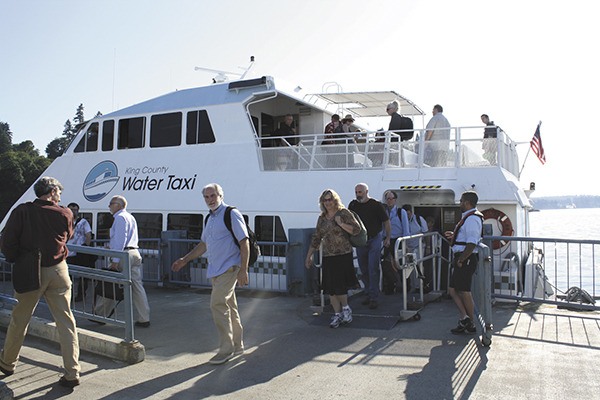As King County takes measures to reduce the cost of running its two water taxis, officials say they will still have to raise taxes to sustain the service past 2016.
The county will rely on the water taxis’ robust financial reserve to keep the passenger ferries afloat for the next two years and recently approved one fare increase for 2016.
“The financial stability going into the future, it’s not great, but it does get better every time we take a look at it,” said King County Councilmember Joe McDermott, who also chairs the King County Ferry District.
When King County took over operation of the Vashon and West Seattle water taxi routes between 2007 and 2009, it established a special purpose district to manage the ferries and levy a property tax of 5.5 cents per $1,000 in assessed value. When the district did not add other passenger routes throughout the Puget Sound as anticipated, the county dropped the tax significantly in2010, to one-third of a cent per $1,000, which also freed up levy funds to support the struggling Metro bus service.
“We raked it in for a while, but then we dropped it,” McDermott said. “We’ve been living off financial reserves all this time.”
While the ferry district built a large reserve during its first few years of operation, McDermott said it’s also been expensive to operate it as a special purpose district — a separate government entity that must hire out for its administrative, legal and accounting needs, rather than use the county’s in-house services. The district also employed one person who managed it, a position that has been vacant for several months.
To save on those redundant costs, King County Council voted last week to fold the ferry district and consolidate it into King County government at the beginning of 2015. McDermott said the move is expected to save about $400,000 a year. The ferry service will be a part of the county’s Department of Transportation and will continue to be managed by the Marine Division.
“I think it’s an excellent thing,” McDermott said of the move.
Even with that and other savings achieved through cost cutting and lower fuel prices, the water taxi service is not sustainable, McDermott said, and the county will rely on the current reserve of about $9 million to sustain it for the next two years. King County will spend about $14 million to operate the ferries during the 2014 and 2015 and will pay about $2 million to build two new water taxis that will join the routes next year. About 80 percent of the cost of the new ferries, which are currently being built, is covered by a federal grant.
McDermott said the council also approved one fare increase in the next two years — a 50-cent hike in March of 2016. Councilmembers will decide in the next two years how much they will raise taxes to cover water taxi costs. The county council has the ability to raise property taxes to cover the water taxi up to 7.5 cents per $1,000.
“It’s a delicate balance in that the ferry district serves a limited number of people in the county, and yet I think it’s an important transit service the county provides,” McDermott said.
Vashon’s water taxi ridership has been on the rise since King County took over the service from the state in 2009. However, ridership has been slightly down this year compared with 2013. There were 157,000 rides on the Vashon route through October of this year, compared with 162,000 by the same time last year.
Paul Brodeur, director of King County’s Marine Division, said the lower ridership could be due to the higher number of cancelled sailings this year, as a backup vessel hasn’t been available as often.
“When you add back in those lost riders, we are pretty much flat over last year,” Brodeur said in an email.
He added that anecdotally, the county believes some are discouraged from riding the water taxi due to a perception that it often fills up. With a current capacity of 172, the Vashon water taxi does sometimes fill, he said, particularly the busy 5:30 p.m. sailing from Seattle. Brodeur believes the problem will be solved when the new boat, with 78 more seats, comes on in April of next year.
“We are confident our 2015 ridership numbers will reflect well as a result,” he said.



